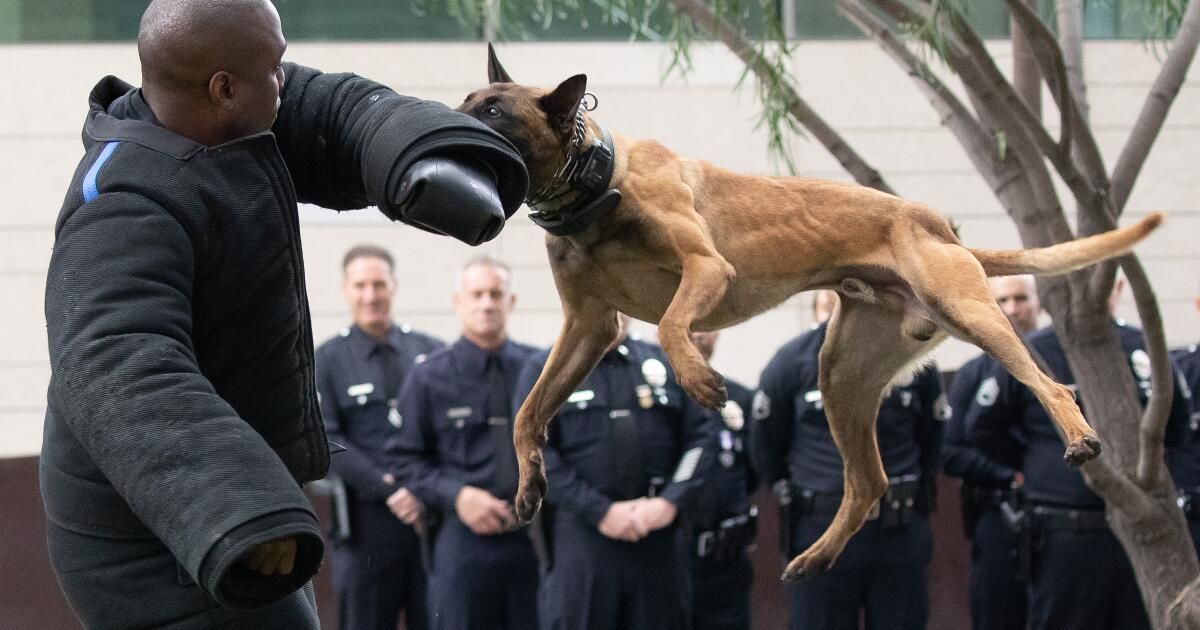When Richard Earl May Jr., 64, entered a construction site in Half Moon Bay to rescue his neighbor's lost cat in January 2015, he set off an alarm that summoned San Mateo County sheriff's deputies to the site with a K-9 unit.
May was unarmed and cooperated with officers, according to the ACLU of Southern California, but the encounter ended with a police dog biting him numerous times, causing severe puncture wounds to his right calf that required hospitalization and left him injured for weeks.
May, who sued San Mateo County after the incident and was ultimately awarded $1.1 million by a civil jury, was one of dozens of cases cited in a policy brief released Wednesday by the ACLU, which said the State law enforcement agencies use K-9 dogs to inflict “unnecessary and disproportionate harm to people” who commit minor crimes.
The civil liberties group said that bystanders and “people experiencing a behavioral health crisis” have also been attacked, and that police have used dogs to “perpetrate racialized violence.”
“There are no state regulations on how canines can be used across our state,” said Eric Henderson, legislative advocate for ACLU California Action. “That means it's up to each department to come up with its own policy.”
Police officials and training experts say dogs used on patrol help protect officers and apprehend suspects, while others trained for detection can help find drugs and bombs.
Javier Acosta, a spokesman for the San Mateo County Sheriff's Department, said that despite the outcome of May's case, police dogs remain “great tools for apprehension, narcotics detection, explosives detection and locating missing people”.
Brad Meyer, founder of Meyer's Police K9 Training in Chico, said the dogs are trained to bite and hold the suspect until the handler arrives on the scene or the dog is verbally told to let go.
“You have to do ongoing training with them on a regular basis,” said Meyer, who noted that dogs in his program can receive ongoing monthly maintenance training for retrieval, search, apprehension, bite, release, control and obedience work.
But according to Henderson, who worked on state legislation introduced last year that aims to regulate K-9 units, dogs used for apprehension purposes are “trained to bite the first person they encounter when they are released.”
“I think people think there are some kind of restrictions on what they can do. [policies] are in effect, and that is not true,” Henderson said. “There are only recommendations.”
Elizabeth Norton, a retired Butte County prosecutor who works with Meyer, said dog handlers must “evaluate a situation second by second whether a deployment is appropriate and [for] how long.”
“You have to call the dog after the suspect sees you come in and surrenders, even if the dog is about to bite,” Norton said. He opposed new state regulations proposed last year and said handlers should rely on “standards [that] “are already in force and are constitutionally appropriate,”
Norton acknowledged that some incidents involving K-9 dogs are “absolutely horrific,” but said that in situations where an armed suspect is dangerous and not complying with officers, “taking the dog out of the equation limits the options an officer has.” official. “
Of the 37 California police agencies analyzed by the ACLU, only the San Jose Police Department explicitly limited the use of canines to situations “involving a threat of serious injury to an officer or another person,” according to the report.
Stephanie Padilla, an attorney with the ACLU of Southern California and co-author of the report, said most of the policies they reviewed were extremely broad and vague.
“There is a discrepancy between how dogs are trained. Some policies include some training guidelines, while others do not include any information on how to train. [K-9s]”Padilla said.
According to the ACLU report, “nearly half of Californians seriously injured or killed by police attack dogs showed signs of a disability or mental health crisis.” In Bakersfield, for example, “more than half of all people seriously injured by an attack dog in 2020 had symptoms of mental illness or impairment.”
“Often,” Padilla said, “what we see is that people experiencing a mental health crisis have a harder time understanding what is happening and require more time to comply with officers' requests. And the officers will continue to release these dogs.”
Sergeant. Bakersfield police spokesman Andrew Tipton said the department had not seen the ACLU report and disputed its conclusions, saying they had eight uses of force involving a police canine in 2020, four of which involved suspects. that “showed signs of alcohol or drug impairment” and another that involves “erratic behavior, for no apparent reason.”
“None of the incidents involved people showing signs of mental disability,” Tipton said.
Dr. Altaf Saadi, a neurologist at Massachusetts General Hospital and assistant professor of neurology at Harvard Medical School, helped write a report by Physicians for Human Rights in conjunction with the ACLU to study the severity of bite injuries. of police dogs.
Saadi told the Times that serious bites can have “lifelong ramifications.”
Dogs often “don't let go when an officer asks them to, so officers have to physically remove them,” Saadi said, which can lead to lacerations, deeper penetrations, scarring, permanent disfigurement, chronic pain and stress disorder. post-traumatic. and exorbitant medical expenses.
“These injuries then spread to other aspects of people's lives from [affecting their ability to] maintaining employment rather than having to be on permanent disability,” he said.
Both the ACLU and Physicians for Human Rights reports found a lack of transparency and accountability regarding K-9 units throughout California. According to the ACLU, no agency “reported disciplining any officers for any use of force involving canines.”
The ACLU also found that “two-thirds of Californians seriously injured by police dogs are people of color,” stating that “Black Californians are 2.6 times more likely to be seriously injured by police attack dogs than white people.” . The report called for new legislation that would “impose strict limits, if not complete elimination, on the use of police attack dogs against the public.”












